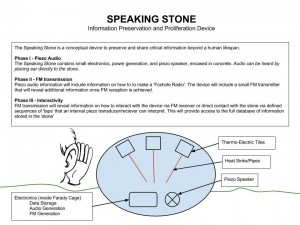This is an evolution of a concept I had for an ‘info-hydrant’ device that would preserve and proliferate information and knowledge in the event of catastrophic loss of technology, communication, and historical information about humanity and nature.
GOAL:
An inexpensive, accessible and easily replicated device that would serve as a repository of information. This device must outlast several human lifetimes, withstand elements and most casual attempts at theft and destruction. The device must be exceedingly simple to use, to the extent that a person with absolutely no knowledge of the device may be reasonably expected to discover it’s function.
PURPOSE/MOTIVATION:
There is a strong chance that some population of human beings will survive catastrophe. There is less chance that deep human knowledge about science, nature, and history will survive the same event. A speaking stone will provide the basis for rapid rebuilding of civilization in the event that communication and information are lost.
The motivation for this can be stated most succinctly in the words of Dian Fossey “When you realize the value of all life, you dwell less on what is past and concentrate more on the preservation of the future.”
CHALLENGES:
Language. This wholly relies on the idea that the language used in the device will be understood by the user. There is no guarantee for this. Essentially I’ve chosen to overlook this challenge and suggest the use of English and hoping that remains a dominant language form into the future. Alternative suggestions on this are welcomed.
Degradation/Theft/Vandalism. There is a possibility these devices will be destroyed by nature, theft, or vandalism. There is no fail-safe against this except by making these devices as physically difficult to destroy as possible, and by proliferating them as far and wide as possible. Another safety would be to encase the electronics in such a way that they cannot be accessed without destroying them. Additionally the value of the contents should be kept as low as possible to discourage attempts.
IMPLEMENTATION:
POWER: Thermo-Electric (Peltier) tiles placed just below the surface of the stone, with one side attached to heat sinks or pipes that run deeper into the core of the stone. The thermal gradient will allow a small array of these tiles to generate enough power (3-5W) to run the electronics.
ELECTRONICS: A Raspberry Pi or similar low power, single board computer could serve as a reliable and inexpensive controller and memory storage. A piezo transducer and possibly a small amplifier will be attached to the audio. In addition, the Raspberry Pi can be used as a simple FM transmitter with no more than a wire as an antennae.
SOFTWARE: Any OS could used, Debian would be fine. A text-to-speech synthesizer program should be installed. Storing information in text format and synthesizing audio will allow vastly more information to be stored than if audio formats were used. RISC OS is another option for the OS and may have more desirable characteristics.
INFORMATION STORED: This requires some thought and I don’t think any one person should decide what information is critical enough to preserve. I’ll leave this open for discussion. I would suggest storing mainly information on science and nature.
—
So that’s my spiel… This concept is clearly in the ‘alpha’ development stage and I’m open and eager for discussion and suggestion on all points. I hope I’ve presented this in a way that it makes sense, if not, open to suggestions on how to do that better too.
